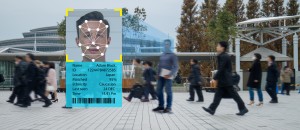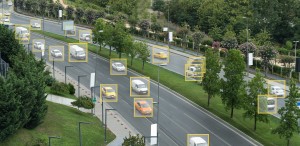Is it praise or worry about privacy leakage to use face recognition technology to improve the efficiency of social regulation?
On the way to the bus station after work, the reporter’s colleagues took out their masks and covered their faces. The reporter asked, “allergic” “No,” my colleague pointed to the red light in front of me, and a woman who was running a red light said, “recently, people who ran a red light without observing traffic rules in Shanghai have received SMS reminders from Shanghai traffic police, reminding them that they did not follow the signal signs of crosswalks in a certain street on a certain day of a certain year, and their behaviors were illegal and recorded by traffic technology monitoring and other equipment, requiring them to be dealt with as soon as possible”
Colleagues sigh: “now technology is changing with each passing day, walking on the road are always under the camera. In order to protect their privacy, it’s better to wear masks on the road” However, I can only regret telling him that the police have publicly declared that even in the dark, even with masks, high-definition cameras and face recognition technology, you can still be recognized in the crowd.
Widely used face recognition
From 2015 to 2017, face recognition technology has experienced rapid development from rapid landing to multi domain application. As you know, the iPhone x can now be unlocked by face brushing, and it can be used by car, pay and walking. Today, “face recognition unlock” has been integrated into all aspects of people’s lives, and plays an important role in finance, transportation, education, security and other fields.
Compared with iris recognition, fingerprint recognition, voice recognition and other biometric technology, face recognition with its unique characteristics has been widely recognized in the market. The technology of early face recognition software is not mature enough, and it is easy to be affected by light, direction or occlusion, which leads to nonstandard contrast results. But after continuous development and improvement, today’s technology has been quite high-end, 3D sensors capture face information, multi camera multi-directional capture, skin texture analysis and even thermal imaging camera data acquisition methods are used in face recognition.
Technology realization of face recognition
There There are three key points in face recognition. The first is face detection, that is, in the dynamic scene and complex background, judge whether there is a face image, and separate this face image. Face detection is a key technology in face recognition. Its methods generally include the methods based on structural features, that is, face detection through skin color, contour, texture, structure or histogram features; Or based on the statistical method, that is, through collecting a large number of “face” and “non face” images to form a positive and negative face sample library, the statistical method is used to strengthen the training recognition system, so as to realize the detection and classification of face and non face. The common algorithms are as follows:
AdaBoost and cascade algorithms
Dyadic wavelet transform
Algorithm based on histogram rough segmentation and singular value feature
Face alignment is the next step after face detection. Once the system detects a face, it will determine the position, size and posture of the head. According to the present values, through the deep learning framework, it will locate the key points of facial features on the face.
Specifically, each face has many distinguishing features, like landmarks on the earth’s surface, which constitute different peaks and troughs of facial features. These landmarks are defined as nodes. Each face has about 80 nodes, and the main features measured by some face recognition software are as follows:
Eye Eye distance
The The width of the nose
Orbital depth
The The shape of the cheekbones
Length of mandibular line
..
After measuring these nodes, the system measures the facial curve with sub millimeter (or even microwave) accuracy and creates a template. The template (data) can be transformed into a unique numerical code and finally stored as a facial imprint to create features for the face in the database.
The second key link is matching
If the captured image is a 3D image and the database contains 3D images, the matching can be realized directly without any changes to the image. However, the content of many databases is still 2D images, which requires certain processing of captured 3D images. At present, the commonly used technology is to focus on identifying different points when shooting 3D images (for example, focus on measuring the outside of the eyes, the inside of the eyes and the tip of the nose, etc.). After obtaining the measurement data, some algorithms can be used to convert 3D images into 2D images, and then compare and match with 2D images in the database.
The third step is face verification and identification
In In the case of verification, the image matches only one image in the database (1:1) to confirm the identity. If it is for identification, the image will be compared with all the images in the database to get the matching score (1: n). In both cases, a matching threshold is usually set. In the verification, if the matching degree between the image and the corresponding image in the database is higher than the threshold, it is the same person, otherwise it is not. In authentication, if the similarity between the image and an image in the database is higher than the threshold, the identity of the image in the database is returned.
Sometimes, the image is not clear or other reasons will lead to verification or identification failure. At this time, the use of skin biometric technology to analyze and compare skin textures is helpful to improve the accuracy of verification. Skin texture analysis works in the same way as face recognition. It also uses an algorithm to obtain skin feature imprint and convert it into digital code to form feature templates. Skin texture analysis is said to be able to identify differences between identical twins. By combining face recognition with surface texture analysis, the recognition accuracy can be increased by 20% to 25%.
Practical application of face recognition technology
Face recognition has a lot of applications in real life. Take face ID technology of iPhone x as an example: users can unlock the mobile phone through the face mapped in the mobile phone camera. Its recognition software adopts 3-D modeling design, which can prevent being cheated by photos or masks, capture and compare more than 30000 variables, and finally verify. However, during the period when the iPhone was hot, doubts about the reliability and security of face ID were rampant. Phishing attacks, malicious image attacks, runtime tampering, and even image theft have all appeared in the discussion topic.
The application of face recognition in the field of traffic and security has been mature for a long time. As early as 2001, Tampa police station in Florida deployed a police camera with a face recognition function. Today, the transportation systems of the United States, Australia, New Zealand, Britain and other countries have deployed more mature face recognition technology. In China, cameras with face recognition technology have also been deployed at railway stations, ports, airports and intersections in many cities to track criminals and detect violations, and certain results have been achieved.
The ensuing privacy concerns
In In March 2018, Shenzhen pedestrian crossing red light exposure platform caused widespread concern and discussion. The information that was exposed on the official website of the exposure stage included the location, time, name of the illegal pedestrian, ID number and photos taken at the intersection. The information is directly displayed on the page without any technical process such as coding. Because the website is open to the public, it is easy to cause the disclosure of citizens’ privacy. After public opinion feedback, the page has been adjusted to hide part of the information of the name and identity account, and code the captured pedestrian’s face. But I’m still worried.
A lawyer said that the traffic police exposure of pedestrian red light running behavior has not been clearly defined in the law, can not be regarded as a legal basis, at most can only play a deterrent role in reason. In fact, this has had a certain impact on the rights and interests of those exposed.
On the other hand, the photos of the offenders are captured on the road, and then they can quickly identify their identities, match their name, ID number information and even send text messages.
According to the police, the “electronic police” or face recognition camera will present the normal traffic flow. If there are retrograde, red light running and other behaviors triggered, several pictures of the offender will be intercepted from the surveillance video as evidence, and a clear face image will be obtained to match with the database. Subsequently, the police will manually verify the information with more than 90% percent similarity, and then determine the identity of the parties. In general, if pedestrians or drivers are disturbed by helmets, sunglasses or masks, as long as the whole face is not covered, the identity can be confirmed by comparing the captured images with the database. Moreover, the transportation department has a huge license plate recognition system, and the body and gait recognition technology is becoming more and more mature.
As early as 2016, the Federal Bureau of investigation (FBI) developed a huge face recognition system, which has access to 4.11 billion photos. Moreover, the FBI has also established a database called “next generation identification” based on the photo library. At that time, the FBI obtained so many Photo resources through “exchange and cooperation” with several States, including the visa and passport database of the State Council, the biometric database of the Ministry of defense, and several driving license databases. According to the law, the FBI had no access to any state’s data. If we need to establish such a system, we need to make an announcement to the public. In addition, the current face recognition system is not equipped with an internal supervision mechanism, which cannot prevent any abuse. At that time, American citizens were also worried and dissatisfied with the violation of their privacy rights by the FBI, but they had nothing to do.
In China, similar problems cannot be ignored. Citizen’s ID card information, real name ticket purchase, entry-exit registration, payment channel face and identity verification, etc., can become the database of transportation department matching and recognition. Today, with real names everywhere, there is no place to hide our identities. We can only expect that the major institutions and organizations holding a huge identity database can “properly” protect this information, neither be stolen by “lawbreakers” nor be abused within the so-called “legal scope”. I hope that people don’t have to worry when they walk on the road, but can interact happily in front of the electronic signs with various functions at the intersection.
Post time: Jul-18-2021



